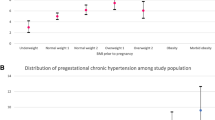Abstract
Objective
This study was conducted to compare underweight and obese women and their weight gain during pregnancy on fetomaternal outcome.
Method
This is a prospective, non-interventional, observational study on 1000 women (BMI between 20 and 30 were excluded). Women attending ANC OPD with singleton pregnancy at or before 16 weeks were included and BMI calculated in early pregnancy. Their weight gain during pregnancy was noted. Any complications in the mother or perinate were noted.
Results
Incidence of obesity in our institute was 17 % and that of underweight was 18 %. Pre-eclampsia, gestational hypertensions, gestational DM, antepartum hemorrhage, all were more common among obese women, while anemia was more common in the underweight. Post-dated pregnancy, induction of labor, cesarean delivery, and postpartum complications were more common in obese women. Fetal complications were also higher in obese patients.
Conclusion
Lower as well as higher prepregnancy BMI is an independent risk factor that is associated with increased morbidity and mortality in both the mother and the fetus.
Similar content being viewed by others
References
WHO Global InfoBase- data and analysis of overweight and obesity, Fact sheet N0, 311, updated on January 2015.
Mohan Reddy N, Kalyana Kumar CH, Jamil K. New world syndrome (obesity) in South India. 2012;1:567 .doi:10.4172/scientificreport.567.
National Family Health Survey on Adult Nutrition. 2005–2006 .
Ahmed SR, Ellah MA, Mohamed OA, et al. Prepregnancy obesity and pregnancy outcome. Int J Health Sci, Qassim. 2009;3(2):203–8.
Institute of medicine. weight gain during pregnancy: reexamining the guidelines. Washington, DC: National Academic Press; 2009.
Elly Tsoi, Humera Shaikh, Stephen Robinson, et al. obesity in pregnancy; a major health care issue. Postgrad Med J. 2010;86(1020):617–23.
Sue Brydon et al. Guideline for low body mass index (BMI) in antenatal women, Nottingham University Hospitals (NHS Trust). July 2015.
Arrowsmith S, Wray S, Quenby S. Maternal obesity and labour complication following induction of labour in prolonged pregnancy. BJO. 2011;118(5):578–588.
Briese V, Voigt M, Wisser J, et al. Risk of pregnancy and birth in obese primiparous women: an analysis of German perinatal statistics. Arch Gynecol Obstet. 2011;283(2):249–53.
Lowe NK, Corwin EJ. Proposed biological linkage between obesity, stress, and inefficient uterine contraction during labour, in human. Med Hypothesis. 2011;76(5):755–60.
Li N, Liu E, Guo J, et al. Maternal prepregnancy body mass index and gestational weight gain on pregnancy outcome. PLoS One. 2013;8(12): e82310. doi:10.1371/journal.pone.0082310.
Flenady V, Middleton P, Smith GC, et al. Stillbirth: the way forward in high income countries. Lancet. 2011;377:1703–17.
Stacey T, Thompson JM, Mitchell EL et al. The auckland still birth study, a case control study exploring modifiable risk factors for third trimester still birth: method of rationale. Aust N Z J Obstet Gynecol, Article first published online 6 Dec 2010.
Makgoba M, Sawidou M, Steer P. The effect of maternal characteristics and gestational diabetes on birthweight. BJOG. 2012;119:1091–7.
Voigt M, Zels K, Guthmann F, et al. Somatic classification of neonates based on birth weight, length and head circumference: quantification of the effect of maternal BMI and smoking. J Perinat Med. 2011;39:291–7.
Ovesen P, Rasmussen S, Kesmodel U. Effect of prepregnancy maternal overweight and obesity on pregnancy outcome. Obstet Gynecol. 2011;118:305–12.
Owens LA, O’Sullivan EP, Kirwan B, et al. ATLANTIC DIP: the impact of obesity on pregnancy outcome in glucose tolerant women. Diabetes Care. 2010;33:577–9.
Modi N, Murgasova D, Ruager-Martin R, et al. The influence of maternal body mass index on infant adiposity and hepatic lipid content. Paediatr Res. 2011;70:287–91.
McDonald SD, Han Z, Mulla S, et al. Obesity and overweight in mothers and risk of preterm birth and low birth weight in infants: systematic review and meta-analysis. BMJ. 2010;341:c3428.
Savitz DA, Stein CR, Siega-Riz AM, et al. Gestational weight gain and birth outcome in relation to prepregnancy body mass index and ethinicity. Ann Epidemiol. 2011;21:78–85.
Aly H, Hammad T, Nada A, et al. Maternal obesity, associated complications and risk of prematurity. J Perinatol. 2010;30:447–51.
Torloni MR, Betran AP, Daher S, et al. Maternal BMI and preterm birth: a systematic review of literature with meta analysis. J Matern Fetal Neonatal Med. 2009;22:957–70.
Driessen M, Bouvier-Colle M-H, Dupont C, et al. Postpartum hemorrhage resulting from uterine atony after vaginal delivery: factor associated with severity. Obstet Gynecol. 2011;117(1):21–31.
Fyfe EM, Thompson JM, Anderson NH, et al. Maternal obesity and postpartum hemorrhage after vaginal and cesarean delivery among nulliparus women at term: a retrospective cohort study. BMC Pregnancy Childbirth. 2012;12:112.
Compliance with Ethical Requirements and Conflict of Interests
Abha Singh and Sumi Agrawal declares that they have no conflict of interest. As this was prospective observational study, not an interventional or case control study, informed conset with human subjects for being included in the study was not necessary, however all procedures followed were in accordance with ethical standard of the responsible committee on human experiments (institutional and national) and with the Helsinki Declaration of 1975, as revised in 2008(5).
Author information
Authors and Affiliations
Corresponding author
Additional information
Sumi Agrawal is Assistant Professor at Pt. JNM Medical College Raipur, Chhattisgarh, India; Abha Singh is Director, Professor & HOD at Pt. JNM Medical College Raipur, Chhattisgarh, India.
Rights and permissions
About this article
Cite this article
Agrawal, S., Singh, A. Obesity or Underweight—What is Worse in Pregnancy?. J Obstet Gynecol India 66, 448–452 (2016). https://doi.org/10.1007/s13224-015-0735-4
Received:
Accepted:
Published:
Issue Date:
DOI: https://doi.org/10.1007/s13224-015-0735-4



